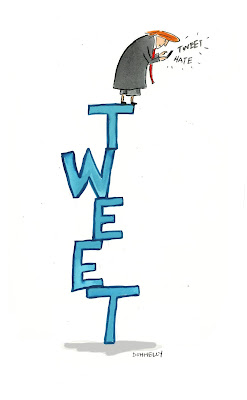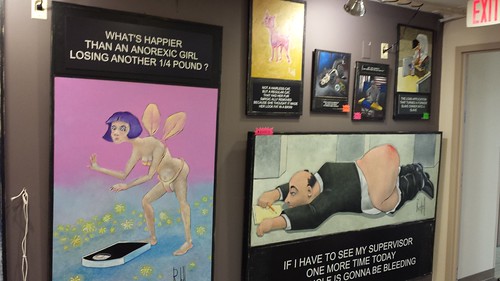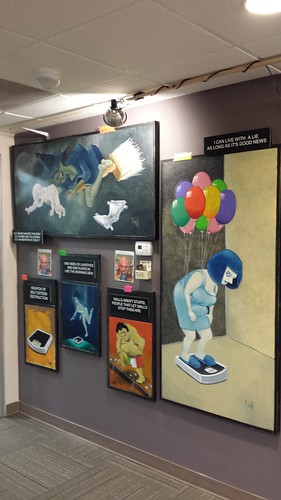by Mike Rhode
I got a tip that cartoons were included in a
US Capitol Visitors Center exhibit about the 'Separation Of Powers.'
I was able to track down cartoonist Dan Rosandich, who confirmed that
the cartoons were his work, but that he wasn't contractually allowed to
talk about doing them. Instead, he answered our usual questions for a
visiting cartoonist.
What type of comic work or cartooning do you do?
I do cartoons that are gag panels and I keep myself "on call" for assignments as I get requests for special custom cartoons through my online web catalog and portfolio pages. I'm currently illustrating a logo for a micro-brewery out east and am almost finished.
I also recently finished a magazine cover for a small trade journal based in Illinois (their October issue in fact)
How do you do it? Traditional pen and ink, computer or a combination?
I am old school, based on drawing these illustrations for 40+ years now. I have tried many drawing nibs, dip pens, markers and micro-tip felt pens and am comfortable using the Rapidograph technical pen. Normally I pencil in a gag cartoon, ink it in using the Koh-I-Noor Rapidograph and let that dry and later I clean it with a soft eraser. I then scan the artwork into Photoshop. I still use Photoshop version 6.0....very antiquated, but it works for me and I can format high resolution cartoon files and store each image into an appropriately named folder on my hard drive for easy access and retrieval.
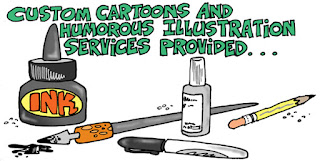
I used to use Higgins Waterproof India Ink for coloring work but it's an obsolete practice I think.... no editor wants to have to get an originally illustrated watercolor, than have to either scan it or make a transparency from it, when all they really need to do is take any properly-formatted files supplied from the cartoonist and import it into their digital publishing software they lay their publication out with.
Technology has really revolutionized the cartooning business from that standpoint. But it's creating original paper images that I like... I could do it all on a Cintiq I guess, but what would I have to hold in my (ink-stained) hands afterwards?
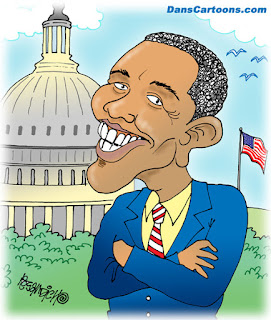 When (within a decade is fine) and where were you born?
When (within a decade is fine) and where were you born?
I was born in 1957 north of Detroit, Michigan.
Where do you live now?
I live in Michigan's Upper Peninsula (aka Yooperland!)
What is your training and/or education in cartooning?
I never went to any fancy art school or had a formal college course in art... I immediately began sending out cartoons to magazines while in my last year of high school and sold one to a trade magazine based in NYC and was "hooked". I still can't describe the feeling you get when you aspire to something you want, and get an acceptance. You immediately get that "I have arrived" overwhelming feeling. And when it happens to a kid, that makes the impact all that much greater and memorable.
It really motivates you.
Who are your influences?
I discovered underground comics as a kid and liked their freedom of expression from the get-go. Robert Crumb's work blew my mind....his attention to detail was / is so great....the cross-hatching and use of black to make characters "pop" is so unique.
The usual comic strip influences were of course Schulz who had already published many
Peanuts anthologies which were huge coffee table size books and I'd go to the library to check them out and leaf through them, absorbing all the in depth line art and the way he'd box in each panel, ever so carefully while smelling the light mildewy odor mixed in with the inks that eminated off each page....I thought I was in nirvana.
I'd also graze all the back copies of
The New Yorker at my high school library and was enthralled with a guy names Marvin Townsend whose gag panels appeared in all the
Weekly Readers I'd go through as a kid.
If you could, what in your career would you do-over or change?
Get a good formal art training or training in architectural design. It would be an asset in making future artwork look much better and in today's digital realm, that training might assist in getting work in other areas of illustration.
Overall, I think I got in the freelance business when there was less competition and cartoonists seemed more willing to share and help one another. Nowadays it's very competitive....especially with everyone having their own online portfolios they can show to get work.
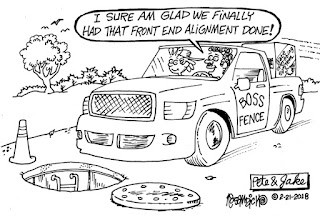 What work are you best-known for?
What work are you best-known for?
Probably 'Pete & Jake' which is a cartoon panel I do for World Fencing Data Center based in Austin, Texas. I have illustrated the cartoon about two bumbling fence installation workers who work for the fictitious Boss Fence Company and their cantankerous 'boss' who also appears regularly in the cartoons in each monthly issue of
World Fence News.
I started in 1995 and just last week finished the latest package of 40 new panels and am just now creating some special color Christmas cartoons for the upcoming holiday season.
They sometimes run a few cartoons in an issue and the following month dedicate a full page to all kinds of panels and a "Best Of" series of cartoons that have appeared in previous issues.
Their editor and publisher are big aficionados of the single panel gag concept and I've also done oodles of strips and other various multi-panels for them. They are a great regular client of mine.
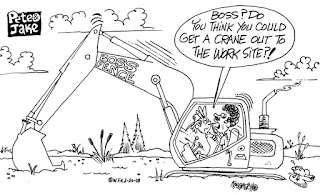
Advertisers seeing my work have also reached out and assigned work used for promoting their own fence or safety-related products.
What work are you most proud of?
Overall, I have to say my entire "body" of work. I have well over 5,000 cartoons I make available throughout my online catalog and my site also acts as a promotional tool in order to get assignments for book illustration work and other custom created cartoons I offer.
But aside from what is online, I have an extensive portfolio of previously published book illustrations, direct-mail projects of illustrated, images for marketers, consultants and facilitators have used numerous cartoons of mine, including custom cartoons for books and presentations, social media, web sites, email "blasts" and more.
I've illustrated everything from book covers and magazine covers to package design and t-shirt illustrations.
What would you like to do or work on in the future?
I would love to publish my own hard-copy catalog. I once had Don Martin of
Mad magazine send me his little catalog offering his originals for sale. It was insane, but it was an impetus for a new idea I always had in the back of my mind.
Only my "catalog" would offer cartoons that advertising agencies could buy for whatever usage they request licensing those specific cartoons for. That hard copy booklet could also be used as a portfolio I could sell if I ever visited a city and went into ad agencies on my own time.
I am still considering my options in regards to it because it takes planning, such as how to acquire names and addresses of the right people to get the catalogs to, what the expense would be (not just for printing) but for getting all the right contact names and then shipping them out.
What do you do when you're in a rut or have writer's block?
I spread things out. I have a subscription to SalesFlower which is an online database that allows you to choose different Standard Industrial Classification codes (SIC codes) of businesses. I pick out phone numbers of art directors or creative directors and make cold calls.
If not that, I switch gears and re-draw old cartoons that never sold or do work I never had time to focus on, such as giftware designs for POD sites (publishing on demand) like Cafe Press or Zazzle (I have accounts with both, but favor Zazzle over CafePress).
If not that, as you well know, paperwork is overwhelming...just cleaning up paperwork can be a relief....focusing on that can have a big impact on changing your outlook to a more positive one.
What do you think will be the future of your field?
The future of cartoons will definitely trend towards digital and the internet. The newspapers have dwindled to the point where comic strips are less and less important based on many factors....so sites like GoComics have taken up promoting those cartoonists online. GoComics isn't interested in my work I don't think, but I know of know fellow artists who report making money through that platform. That's not to say that they aren't trying, but I feel it's more in each respective cartoonist's court, to promote themselves. Build their own sites and display their work to the world on their
own...don't be part of a collection where you get lost in the shuffle. I'm not sure that's good. Your work will have it's own uniqueness if it stands alone and you present it in such a way that it's "marketed" to the right potential clients.
What conventions do you attend?
I attend no conventions as I have nothing to sell, aside from original gag panels, but I don't consider my original art as a "collectible" in any way. It's likely they'd say "Who's Rosandich?"
Have you visited DC before?
I haven't, but it's definitely on my list!
If not, what do you want to do?
I'd like to get to the U.S. Capitol . . .don't ask me why! And so many other famous monuments I would see there....plus I have an old school classmate who lives there and he was a Congressional guard in the military who said he can show me around the beltway and surround areas. The Smithsonian would be considered a "bucket list" visit!
Do you have a website or blog?
My main web site home page is at
https://danscartoons.com and my blog I write, focuses solely on cartoons, comic strips, the cartooning business, cartoonists and I occasionally reflect on things related to cartooning such as gag writing and promoting and marketing your cartoons on a freelance basis. My Toonblog can be found at
https://danscartoons.com/toonblog/















